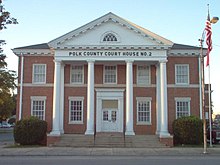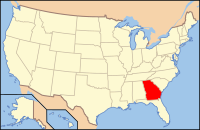Polk County, Georgia
| Polk County, Georgia | |
|---|---|

Polk County Courthouse in Cedartown
|
|
 Location in the U.S. state of Georgia |
|
 Georgia's location in the U.S. |
|
| Founded | December 20, 1851 |
| Named for | James K. Polk |
| Seat | Cedartown |
| Largest city | Cedartown |
| Area | |
| • Total | 312 sq mi (808 km2) |
| • Land | 310 sq mi (803 km2) |
| • Water | 1.8 sq mi (5 km2), 0.6% |
| Population | |
| • (2010) | 41,475 |
| • Density | 134/sq mi (52/km²) |
| Congressional district | 14th |
| Time zone | Eastern: UTC-5/-4 |
| Website | www |
Polk County is a county located in the northwestern part of the U.S. state of Georgia. As of the 2010 census, the population was 41,475. The county seat is Cedartown. The county was created on December 20, 1851 by an act of the Georgia General Assembly and named after James K. Polk, the eleventh President of the United States.
Polk County comprises the Cedartown, GA Metropolitan Statistical Area, which is also included in the Atlanta-Athens-Clarke County-Sandy Springs, GA Combined Statistical Area
According to the U.S. Census Bureau, the county has a total area of 312 square miles (810 km2), of which 310 square miles (800 km2) is land and 1.8 square miles (4.7 km2) (0.6%) is water.
Most of eastern Polk County, centered on Rockmart, is located in the Etowah River sub-basin of the ACT River Basin (Alabama-Coosa-Tallapoosa River Basin), while most of western Polk County, centered on Cedartown, is located in the Upper Coosa River sub-basin of the same ACT River Basin. Small slivers of the southern edges of the county are located in the Upper Tallapoosa River sub-basin of the same larger ACT River Basin.
As of the census of 2000, there were 38,127 people, 14,012 households, and 10,340 families residing in the county. The population density was 122 people per square mile (47/km²). There were 15,059 housing units at an average density of 48 per square mile (19/km²). The racial makeup of the county was 80.52% White, 13.34% Black or African American, 0.22% Native American, 0.31% Asian, 0.04% Pacific Islander, 4.62% from other races, and 0.95% from two or more races. 7.66% of the population were Hispanic or Latino of any race.
...
Wikipedia
